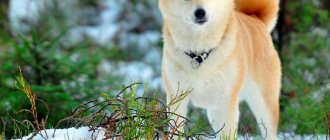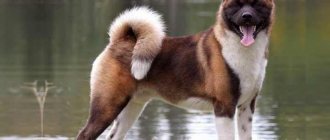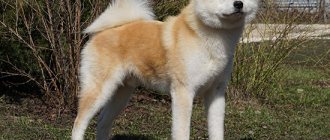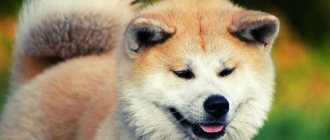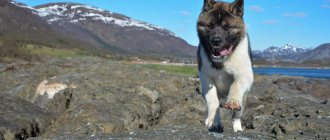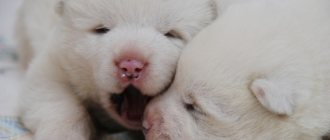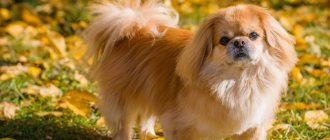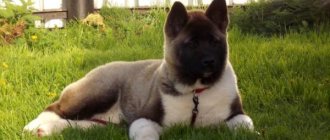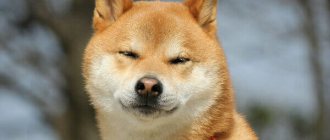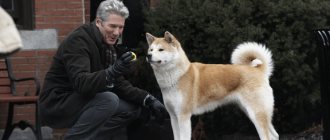History of the American Akita
American Akita
The word "American" in the breed's name can be confusing when it comes to its origins. The second name - large Japanese dog - is more eloquent in this regard: its homeland is the Land of the Rising Sun. But how did it happen that the Akita suddenly became American?
The ancestors of the American Akita are the Japanese Akita Inu, which were originally used for hunting and guard purposes. Several centuries ago they were called differently: Matagi-Akita. Later they began to be used in dog fighting, which became especially popular at the turn of the 19th and 20th centuries. In pursuit of monetary gain, owners sought to “improve” their dogs, making them larger and stronger. For this purpose, they were crossed with breeds brought to the islands such as mastiffs and shepherd dogs.
However, as a result of these manipulations, the classic features of the breed began to blur, deteriorate, or even be completely lost. The damage caused to the Matagi Akita was noticed at a dog show held in Tokyo in 1914. Soon, pure representatives of the breed were declared natural monuments, and their crossing with representatives of other species was strictly prohibited. The breeders had more work to do: they did everything possible to return the Matagi Akita to its original characteristics.
Before these magnificent dogs, which became the source of national pride for the Japanese, had time to recover from the blow inflicted on the breed by irrepressible human greed, World War II broke out. By order of the government, all breeders donated their pets to the needs of the front. As is known, the end of the war was marked by the surrender of Japan in 1945. Returning to their homeland, US military personnel decided to take with them several puppies they liked. It was they who became, a few years later, the progenitors of a new breed. But the actual classic Akita Inu remained on the Japanese Islands after the war, no more than 20 individuals.
Japanese Akita Inu
At the same time, overseas the breed began to gain widespread recognition and developed at a rapid pace. At first it was called a large Japanese dog. But in the States, work on the breed was not synchronized with the Japanese - it proceeded in parallel and, as they say, on its own path. Japanese breeders tried to negotiate with their American colleagues regarding her common pedigree, but in vain. They did not even allow dogs declared natural monuments on the islands to be exported to the United States. All these measures did not stop the Americans. As a result, over time, the overseas Akita began to differ from the Japanese one in both appearance and character. And then it received a new name - American Akita.
In 1956, a club for the newly formed breed was created, recognized by the American Kennel Club only in 1972. The “breed war” with Japan continued until 1992: for two decades, the kennel clubs of both countries did not recognize each other - only the Japanese Akita Inu was registered with the Fédération Cynologique Internationale (FCI). The official division of the breeds occurred only in 2000, when the FCI approved the standard for the overseas Akita.
History of the origin of the species
The breed's ancestor was developed in Japan at the end of the 19th century by crossing Akita Matagi, a hunting breed, with Tosa Inu and mastiffs. The dogs were quite large and were used for fighting and hunting. Only people of aristocratic origin could afford to have such a dog. In the 20th century, fighting was outlawed, but the breed was still in demand among breeders.
The Akita was brought to America by soldiers after World War II, taking with them several puppies. For a long time, the breed was used to obtain warm fur and was close to complete extermination. Breeders raising dogs as pets have had their animals taken away by the police.
American breeders hid Akitas and crossed them with German shepherds, thus saving them from the authorities.
As a result, by the age of 50, a new breed had emerged, distinguished by its larger size and coat color . The outline of the muzzle has changed somewhat, the bones have become more massive. A club for lovers of the large Japanese dog was created in the USA in the mid-70s.
The final division of the species into Akita Inu and American Akita occurred in 2000; in 2015, the species was officially included in the lists of the International Canine Federation.
The American Akita is currently used as a service dog, as well as as a companion for owners of country houses.
Features of the American Akita
The American Akita is an excellent hunter. If you suppress this natural quality in a dog, it will still manifest itself in one way or another, and not in the most pleasant way for the owner. For example, on a walk your pet will begin to rush at smaller dogs or “bully” the cat living in the same house.
The American Akita is also called a one-owner dog. She has a very hard time with a change of owner and often cannot adapt to living in another place for the rest of her life. A classic example is the famous Hachiko, an Akita Inu dog, who gained fame throughout Japan in 1932 after the publication in one of the largest Tokyo newspapers of the article “A devoted old dog awaits the return of his owner, who died seven years ago.” Based on this story, which touched the hearts of millions of people around the world, a film was made in 2009 with Richard Gere in the title role.
As you can see, the American Akita inherited this quality from its Japanese counterparts - devotion. It will be especially difficult to find common ground with an adult dog for those new owners who have not previously had experience communicating with large Molossians.
FCI breed standard No. 344 American Akita (Large Japanese Dog), 02/14/2001
- Dogs
- Dog breeds: all dogs from…✔
- American Akita
- FCI Breed Standard No. 344…✔
INTERNATIONAL CYNOLOGICAL FEDERATION FCI Standard No. 344/14.02.2001 - Translation from English AMERICAN AKITA (FORMERLY NAME - LARGE JAPANESE DOG)
COUNTRY OF ORIGIN: Japan COUNTRY OF BREED DEVELOPMENT: USA DATE OF PUBLICATION OF THE ORIGINAL CURRENT STANDARD: 10/25/2000
FIELD OF APPLICATION: Companion dog CLASSIFICATION IN THE FCI SYSTEM:
Group 2 - Pinschers and Schnauzers - Molossians - Swiss Mountain Dogs, Cattle Dogs and Related Breeds Section 4 - Related Breeds
No operational tests
GENERAL APPEARANCE: Large, strongly built dog, well balanced, powerful and solid in build (with considerable substance) and heavy boned. The breed is characterized by a wide head in the shape of an obtuse triangle: with a deep muzzle, relatively small eyes and erect ears, which are almost in line with the back of the neck.
IMPORTANT PROPORTIONS: The ratio of the height at the withers to the length of the body is 9 to 10 for males and 9 to 11 for females. The depth of the chest is equal to half the height of the dog at the withers. The ratio of the distance from the tip of the nose to the stop to the distance from the stop to the back of the head is 2:3.
BEHAVIOR AND TEMPERAMENT: Character is friendly, receptive, with a developed sense of self-esteem, obedient and courageous.
HEAD: Massive, but in proportion to the body, in a calm state without wrinkles. When viewed from above, it has the shape of an obtuse triangle. Cranial Region: Skull: Flat and wide between the ears. The shallow hollow between the eyes extends well into the forehead. Stop: Well defined, but not too sharp.
Facial region: Nose: Large and black. Minor and scattered depigmentation is allowed only with a white coat, with a black nose being preferred. Muzzle: Broad, deep and full. Lips: Black. Not saggy; tongue pink Jaws/teeth: The jaw is not rounded, but blunt, strong and powerful. The teeth are powerful, arranged regularly, in full set; A scissor bite is preferred, but a straight bite is acceptable. Eyes: Dark brown, relatively small, not protruding, almost triangular in shape. The eyelids are tight-fitting and black. Ears: firmly set, small in relation to the size of the head. If the ear is tilted forward, its tip touches the upper eyelid. The ears are triangular in shape, with slightly rounded ends, wide at the base, not set too low. When viewed from the side, the ears are tilted forward towards the eyes, continuing the line of the neck.
NECK: Thick and muscular, with minimal dewlap, relatively
short, gradually widening towards the shoulders. The pronounced scruff smoothly passes into the base of the cranial part of the head.
BODY: The length of the body exceeds the height at the withers. The leather is not too thin, not too tight, but not too loose either. Back: level (straight) Loin: Firmly muscled Chest: wide and deep. The ribs are well arched, the sternum is developed. Belly: moderately tucked
TAIL: large, well-furred, set high, carried over the back or extended along the body, forming a three-quarter ring, a full single or double ring, always lying on the back or falling below the level of the back. If the tail is curled three-quarters of the way, the tip hangs significantly to the side. The base of the tail is large and powerful. When deployed, the last caudal vertebra reaches the hock joint. The hair on the tail is coarse, straight and dense, while the tail does not take on the shape of a feather.
LIMBS: FOREQUARTERS: strong boned, straight when viewed from the front. Shoulder: Strong and powerful, with moderate slope. Pasterns: slightly sloping forward, at an angle of about 15′ to the vertical. HIND LIMBS: powerfully muscled, width and bones comparable to the forelimbs. The dewclaws on the hind limbs are traditionally docked. Hips: Powerful, well developed, parallel when viewed from behind. Knee joints: moderately pronounced Metatarsus: short, parallel (turned neither in nor out) FEET: cat paws, straight, with protruding knuckles and thick crumbs
MOVEMENT: powerful, with moderate reach and push. The hind legs move in the same plane as the front legs. The back remains strong, firm and even when moving.
COAT: Coat: Double coat. The undercoat is thick, soft, dense, shorter than the topcoat. The integumentary coat is straight, coarse/hard, slightly behind the body. The hair on the head, lower legs and ears is short. The length of the coat at the withers and croup is about 5 cm, on the remaining parts of the body it is slightly longer; on the tail the hair is longest and most abundant. Color: Any color, such as red, fawn, white, etc.; may also be piebald or brindle. All colors are clear and bright, markings are well balanced, a mask or blaze may be present. Solid white dogs do not have a mask. In piebald dogs, large spots are evenly distributed on a white background, covering the head and more than one third of the body. The color of the undercoat may differ from the color of the topcoat.
SIZE: Height at withers: Male: 66-71 cm (26-28 inches) Female: 61 -66 cm (24-26 inches)
FAULTS: Any deviation from the above requirements is considered a fault and its severity is assessed strictly in proportion to its severity. • Deviation from the sexual type (male in the bitch type or bitch in the male type) Narrow or cramped muzzle Missing any tooth (except 2 from PM1 and/or MZ) Tongue with blue or black spots Light eyes Short tail Turned in or out elbows Any signs of a collar or fringe Timidity or viciousness
FAULTS: Light substance Light bone
DISQUALIFYING FAULTS: Completely depigmented nose. Nose with depigmented areas (“butterfly”) Drooping or semi-erect ears Overshot or undershot Tail, crescent-shaped or not curled Male less than 63.5 cm (25 inches), female less than 58.5 cm (23 inches) at the withers.
N.B.: Males must have two normal, fully descended testicles
Appearance of the breed
American Akita puppy
The American Akita is a very large dog. Strength and power can be read in her every movement. Gradually, the hunting skills of these dogs are becoming a thing of the past, which is largely due to their large size, which prevents the overseas “Japanese” from remaining fast and agile hunters.
Thanks to its special appearance features, namely its spectacular color and perfect lines, the American Akita has long been “registered” at dog shows in different countries of the world, including Russia. Representatives of the breed often lead in BESTS of the fifth group, often winning entire competitions.
general description
It is very difficult to confuse an American Akita with another breed - it is almost impossible, even if before “personal acquaintance” you had only seen it in a photo. The first thing that will catch your eye, in addition to its impressive size, is its strong body with well-developed muscles and massive bones. The “bear” type muzzle with small eyes and a relatively short bridge of the nose will definitely attract attention.
The height and weight of the American Akita, as well as the proportions of the body, vary depending on gender. The height of males at the withers varies from 66 to 71 cm, females - from 61 to 66 cm. The weight of adults is usually: males 45-65 kg, females 32-45 kg.
For males, the ratio of the height at the withers to the length of the body is 9:10, for females it is 9:11. The distance from the foot to the tip of the nose correlates with the distance from the foot to the occipital protuberance in a ratio of 2:3.
Head
American Akita muzzle
The head is the hallmark of the breed. Massive, but at the same time in harmony with the body. There are no skin folds (wrinkles) - provided that your pet is in a calm state. When viewed from above, the shape of the head resembles an obtuse triangle.
The skull is wide and flat, with a shallow groove running upward along the forehead. The transition from forehead to nose (stop) is well expressed, but not sharp.
Wide and voluminous muzzle with powerful, square-shaped jaws. The suspension of the jaws is light. The ratio of muzzle length to skull length is 2:3.
Teeth
The bite is characterized as a regular scissor bite. However, the breed standard also allows for a straight bite. The teeth are strong, the dental formula must be completely present.
Eyes
The Akita's eyes are small, almost triangular in shape, and deep-set relative to the size of the head. Color – dark brown. The eyelids are black and fit tightly.
Ears
The ears are also small in relation to the rest of the head.
Standing, triangular in shape. They have a wide base on strong cartilage, slightly rounded at the ends. The setting is not too low. Above the eyes, at the level of the scruff of the neck, slightly tilted forward. When pulling the ear forward, its tip should ideally touch the edge of the upper eyelid. If you look at the Akita's ears from the side, they seem to continue the top line of the neck.
Nose and lips
The nose is black, wide, the nostrils are well open. Liver color is allowed, but only the American Akita is white. Although it is still preferable to “classic” the breed, that is, the black color of the nose.
The lips are also black, dry, and fit tightly. The tongue is pink.
Neck
Massive, thick and relatively short, with minimal dewlap. Muscular, widening towards the shoulders. The scruff has a good convexity, smoothly passes into the base of the skull and merges with it.
Frame
The body length of the American Akita exceeds the height of the dog at the withers. The chest is wide, voluminous and deep.
The depth of the chest is equal to half the height of the animal at the withers. The ribs are distinguished by sufficient convexity (arched).
The belly is moderately tucked. The back is straight, the lower back is muscular and strong, with a slight convexity. The skin is elastic and fits tightly.
Tail
Covered with straight, thick and coarse hair, it does not form a dewlap. Its base is large and powerful. The tail is set high and the Akita carries it over its back. Or, as an option, the tail touches the side. The tip must reach the back or fall below its level.
The tail is bent into a ring, sometimes double, forming three-quarters of a circle. The last vertebra, when fully rotated, reaches the hock joints.
Limbs
The forelimbs have powerful bones and look straight when viewed from the side. Shoulders moderately sloping back, strong and firm. Elbows should look strictly back, not turned outward or inward. The pasterns have a slight slope, about 15 degrees to the vertical. The paws are round in shape, “cat” type, the direction is straight. The pads are thick and elastic, the fingers are arched with strong claws.
The hind limbs are also distinguished by strong bones and powerful muscles. Hips are well developed and strong. The metatarsals have a fairly low location and are not turned outward or inward. The knee joints, when viewed from behind, are parallel and characterized by moderately pronounced angles. Paws are straight-directed, with elastic pads, round ("cat" type). The fingers are convex (arched) and equipped with strong claws. The so-called dewclaws, that is, the fifth in a row, are usually removed.
The American Akita's gait is characterized by strong, free movements. They are also distinguished by a moderate lunge and push. The movement of the front and hind limbs is carried out in the same plane.
Wool
The coat is double and has a dense undercoat. The guard coat is coarse and straight, while the undercoat is soft and dense and somewhat shorter in comparison with the outer coat.
The hair on the head, ears and limbs is short. Its length at the rump and withers is approximately 5 cm, which is slightly longer than on other parts of the body, with the exception of the tail. It has the longest and most abundant fur – over 6 cm.
Color
White American Akita
The breed standard here is very democratic, allowing any color options, including white, fawn-white, red and brindle. American Akitas can even be piebald, that is, spotted (pinto) - with or without a mask. Instead of a mask, there may be a spot on the forehead or a dent on the muzzle. The mask is completely eliminated only in white individuals. White individuals have black lips, nose and pads.
The colors of dogs of this breed are clear and pure. The spots have clear contours and are evenly spaced. In the Pinto, the spots on a white background are evenly distributed, covering the head and more than one third of the dog's body; a dark-colored mask is allowed.
The color of the undercoat may differ from the coat color.
Possible defects
- Absence of any tooth, with the exception of 2 PM-1 and/or M3.
- Short tail.
- Light eyes.
- Males of the bitch type and, accordingly, bitches of the male type.
- The tongue is blue or with black spots.
- The presence of a collar or fringes.
- Turning of the elbows (inward or outward).
- Anger or, conversely, timidity.
- Lightweight frame.
- Insufficient body weight.
Disqualifying faults
- Partially or completely absent pigmentation of the nose (the so-called butterfly nose).
- Overshot or undershot.
- Semi-erect or completely drooping ears, with folds.
- The tail is straight or crescent shaped.
- The height of males at the withers is less than 63.5 centimeters, and that of females is less than 58 cm.
- Aggression or cowardice.
Any obvious physical abnormalities or problematic behavior is grounds for disqualification of the American Akita.
Please note: male dogs must have two healthy, developed testes, fully descended into the scrotum.
Description of the breed
FCI Standard No. 344 dated January 29, 2015 “American Akita” Group 5 “Spitz and primitive type breeds” Section 5 “Asian Spitz and related breeds”
The height of an adult male is from 66 to 71 cm, weight is from 50 to 68 kg. The female’s height is from 61 to 66 cm, weight is from 46 to 56 kg.
The dog is distinguished by a strong and powerful physique, harmoniously built. A wide head in the shape of a blunt wedge, a deep muzzle, small eyes, erect ears, continuing the upper line of the neck and directed forward, are characteristic features of the breed.
Nose color depigmentation is only permissible for dogs with white coats.
| HEAD | Massive, but in harmony with the body, in a calm state without wrinkles. When viewed from above, it has the shape of a blunt wedge. |
| EYES | Dark brown, relatively small, non-convex, almost triangular in shape. The eyelids are black and tight-fitting. |
| EARS | They have a triangular shape, wide at the base, not set too low. They stand firmly and are small relative to the head. If you bend the ear forward to control the length, then its tip should touch the edge of the upper eyelid. |
| TEETH | Strong with regular arrangement and complete formula; A scissor bite is preferred, but a level bite is acceptable. The jaws are not rounded, blunt, strong and powerful. |
| NECK | Thick and muscular, with minimal dewlap; relatively short, gradually widening towards the shoulders. The noticeably convex scruff blends harmoniously into the base of the skull. |
| BREAST | Wide and deep. Ribs well arched. |
| PAWS | Feline, directed straight, with a good arch, with thick pads. |
| FRAME | Length exceeds height at withers. The leather is not too thin, not too tight, but not too loose either. |
| TAIL | Powerful, richly coated, set high, carried over the back or touching the side, forming three-quarters of a circle, curled into a ring or double ring, the tip always reaching the back or falling below the level of the back. |
The coat is double: undercoat and guard hair. The undercoat is thick, soft, dense, shorter than the top coat. The guard hair is straight, coarse and somewhat lagging behind the body. The hair on the head, lower limbs and ears is short. The length of the hair at the withers and croup is about 5 cm, so it is slightly longer than along the body, with the exception of the tail, where the hair is longest and most abundant.
All colors are allowed, such as red, fawn, white, etc., including brindle and spotted. All colors are clean and bright, the spots are distributed evenly, with or without a mask, blaze.
Solid white dogs do not have a mask.
In spotted dogs, large spots are evenly distributed over the white background, covering the head and more than one third of the body. The undercoat may differ in color from the topcoat.
Photo of an adult American Akita
Character of the American Akita
The American Akita is distinguished by its independent and freedom-loving disposition. But at the same time, this is a calm dog, affectionate, balanced. Thanks to her mature, stable psyche, she behaves with dignity and shows restraint in any situation.
Waiting for the owner
Representatives of the breed never have causeless reactions to external stimuli. She does not bark over trifles, and without good reason she does not rush at anything that moves, just because it moves. Akita - smart, reserved, well-mannered and noble - such behavior is completely unusual.
If you keep your pet in an ordinary city apartment, you don’t have to worry that the American Akita will cause any inconvenience to your neighbors. There will certainly be no complaints about constant barking and howling. But if an Akita starts to vocalize, you can rest assured that there is a good reason for it! The barking of your pet is a sure signal that an ill-wisher has encroached on your territory or your property.
Dogs of this breed, like real samurai, love to keep everything under their control - apparently, this is how the genes inherited from their Japanese ancestors manifest themselves. This quality in the American Akita can be called one of the fundamental, because it helps her in fulfilling the mission inherent in nature - to be an excellent watchman. Take a closer look at your dog when he surveys his possessions: there is something bewitching in his gaze, inaccessible to human understanding.
The American Akita is distinguished by its boundless devotion to its owner and his family members. Like the Cane Corso, she gets along very well with children, often even looking after them like a nanny. But, unlike the “Italian,” our “American” cannot be trusted with children who are too young. Not at all because he is capable of offending them. On the contrary, when he feels threatened, he will, without hesitation, rush to protect the little household members. An Akita cannot be a full-fledged nanny due to its size. Leaving the baby alone with her, you cannot be completely sure that the dog will not accidentally push him or cause him some kind of injury. For some of the younger family members, the Akita will become a true friend, especially for teenage children. They won't find a better companion in active games and various pranks!
At the same time, the breed is absolutely not characterized by such traits as obsessiveness and importunity. Although the Akita was specifically bred to live with humans, it still needs its own space. The “American” will never get in your way, but at the same time, you should not impose yourself on him again.
American Akita with a child
The peculiarities of the “inner world” of the breed also include intolerance to rudeness on the part of the owner and other household members. If an American Akita is yelled at or punished unfairly, she becomes very offended. Never raise your voice at your pet, do not offend him, and especially do not use physical punishment on him.
The American Akita feels great in a country house with a spacious yard. A large territory is her element: there is something to protect, and there is a place to feel like a master. When keeping a dog in an apartment, under no circumstances turn your pet into a “prisoner” of your square meters. A representative of this breed needs not only regular, but also long walks. Moreover, you need to walk him twice a day for at least 1-2 hours. Walking just “for show” is not suitable for Akita. They should be interesting, rich, active, with elements of play and training. All these points will help maintain the dog’s physical and mental health at the proper level.
The American Akita has a remarkable memory and trusts its owner, so it is very important not to deceive the dog, it does not like this and remembers such moments for the future. That is, if you, for example, lured her with a treat or gave the command “Eat!” or “Go for a walk!”, but didn’t do anything, then you risk losing your pet’s trust: he will stop perceiving you as his leader.
Quite often, a problem such as aggression towards other dogs arises in Akita behavior, which can cause some trouble for the owner. It is to dogs: she often shows loyalty to cats, but only to “her own” - there will simply be no strangers in the territory she controls. As for other people's dogs, adult Akitas, especially males, almost never accept other dogs into their company. On walks, they often show their character not from the best side, provoking quarrels and fights. From this we draw a simple conclusion: when you find yourself with your pet in dog walking areas, under no circumstances let him off the leash.
American Akita with owner
History of the breed
Most Japanese dogs were "Akita-like". Compact build, thick coat, erect triangular ears, tail wrapped in a ring - all these signs brought them closer to the appearance of huskies. True, most Akitas had long hair on the cheekbones, and some individuals had a blue tongue. All these varieties differed only in size and color.
It must be said that the Akita is the oldest Japanese breed. Archaeologists have discovered clay figurines of dogs made around the 2nd millennium BC. e.
The appearance of these ancient dogs resembles that of the Akita. It is believed that the breed was developed by crossing dogs from the north of the country with large Chinese Gou dogs.
The Akita's ancestors have been popular throughout time, but were primarily used by people in northwestern Japan. The archives contain records dating back to the 6th century, which detail the rules for raising and breeding these hunting dogs. Strong pets took part in hunting deer, wild boars and even bears.
Gift of the chroniclers
The Japanese began keeping stud books for their dogs 300 years earlier than the Europeans. The indigenous people valued their ancestral breeds very much. When European dogs began to enter the country through Asia in the 16th century, the Japanese developed a classification of their four-legged friends. They divided them into working dogs, domestic dogs and imported ones. Of course, the latter were not allowed to be selected.
Hunter and watchman
Photo: American Akita
Over time, the professional skills of dogs have expanded significantly. Already in the Tokugawa era, Akitas became excellent watchdogs. They protected Japanese houses from thieves and the owners' families from intruders. Thick, warm wool allowed them to live on the street all year round and perform their service regularly.
Japanese mountaineers still used the Akita to hunt bears and other animals. In fact, it was a versatile breed that coped well with many responsibilities.
At the end of the 19th century, the Akita acquired another profession. By crossing the breed with European newcomers: the English Mastiff, the Tibetan Great Dane and the St. Bernard, a fighting variety was developed. But these dogs had nothing in common with their ancient relatives. And although fights were banned in 1908, they continued to be carried out clandestinely, and the bred dogs were worth their weight in gold.
By this time, real Akitas survived only in remote Japanese villages. Here they were still used to protect homes and hunt large animals.
On the verge of extinction
In 1854, Japan signed a treaty with the United States to open ports. The country was immediately flooded with foreigners. Many of them took their faithful four-legged friends with them. At that time no one controlled the crossing of native breeds. Therefore, the number of purebred Akitas began to decline rapidly.
It was only in the 1920s that the government became concerned about their fate. The Society for the Preservation of Native Japanese Breeds was founded. This organization renewed the tradition of keeping stud books. In addition, she began to hold dog shows and recognized several native Japanese breeds, including the Akita.
Alas, during the Second World War, the work carried out came to naught. The Akita population in Japan has declined significantly. The soft fluffy fur of these dogs was very attractive, so the military often used it to make warm sheepskin coats. The country's government saved the breed, which was disappearing before our eyes. Politicians have taken control of the dog population. The Akita population was heterogeneous: it included fighting dogs, Akita Shepherd Dogs, and Matagis, the only ones that retained the features of ancient Japanese breeds.
They became the parents of the updated Akita. We had to carefully select dogs without “European” impurities. The breeders' painstaking work to restore the Akita ended in 1963, when the Japanese Kennel Club recognized the breed.
Hello America!
At the same time as the Japanese, the Americans also became interested in Akita. During World War II, US soldiers brought large dogs from the land of the rising sun to their homeland. Beautiful and brave dogs immediately became popular in the States.
Already in 1956, the first club of breeders of the breed appeared. True, the direction of their work differed from the goals of Japanese dog handlers. While the Japanese were trying to return the Akita to its ancient appearance, the Americans tried to create a completely new dog. They succeeded by 1960.
A big difference
Modern Akitas, both Japanese and American, are quite different from the ancient aboriginal dogs of Japan. To notice this, just look at the stuffed dog Hachiko in the Tokyo Museum of Natural Sciences. Ancient Akitas looked even simpler and more ferocious, because they were used for protection and hunting.
One or two?
The fate of Akitas in Europe is interesting. Both “Japanese” and “Americans” were brought here. For a long time they participated in exhibitions on equal terms as one breed. But by the end of the 1980s, Japanese breeders finally decided on the appearance of their brainchild. They brought the Akita closer to the Spitz-shaped, fox-headed dogs. In addition, individuals with a black mask and a spotted coat, which were often found in American Akitas with bear-like facial features, were excluded from breeding.
In 1996, most countries recognized the breeds as different. And only in the USA, Canada and Great Britain this division does not apply. Here both types of dogs are often used for breeding.
Training and education
Raising and training the American Akita should only be done by an adult with experience, will and a steady hand. The breed is not suitable for weak-willed people, not to mention the elderly and people with disabilities.
Training an Akita can be hard work for many, even experienced owners. But this is not at all because a dog of this breed is “slow-witted.” On the contrary, by nature she has an extraordinary mind, and before executing a command given to her, she will first think about whether it is worth doing. From the outside, it may look like the Akita did not understand what they wanted from her. It also matters how authoritative the owner is in her eyes. The “American” will obey only the one whom he considers his leader, his leader.
American Akita training
For the most part, American Akitas are very active and learn, generally speaking, quickly. But they, like people, can get stuck with routine. In the sense that a dog can simply get bored from following the same commands, therefore motivation is very important in the process of training and education. At the initial stage, it will be easy to get by with just praise and treats. In the future, you will have to show your imagination in what else to interest your pupil.
It happens that the puppy begins to demonstrate character: he is stubborn and does not want to follow commands. This is where we need to show who is in charge. This is quite simple to do: press the capricious one with his back to the floor and hold him in this position until he stops offering resistance. Or grab the puppy by the withers and press him to the floor - this method is also effective. At first glance, it may seem that with such actions the owner is showing violence towards the dog. However, in fact, these are effective ways to convey to the dog that he is its leader, and that he is stronger. In the future, the Akita will more than once try to take a leadership position, checking through disobedience to see if the owner has weakened his “grip” or begins to give in to her. Don't fall for such tricks!
The main purpose of the American Akita is to protect its owner, and it will try to always be nearby. To prevent such “care” from the pet from causing inconvenience, in the process of training and raising the puppy, it is necessary to pay special attention to the “Place!” command. Otherwise, the dog will be on duty near the closed door, waiting for you from work, sleep by your bed and persistently watch near the locked door to the bathroom.
Care and maintenance of the American Akita
Since Akitas are quite heavy-boned, puppies should not be overloaded. Do not force four-legged adolescents of this breed to carry weights for muscle development. Joints, ligaments and muscles should become stronger only as a result of balanced feeding and loads commensurate with the pet’s age.
Although the Akita has a luxurious coat, it does not require frequent brushing. Only during molting will grooming have to be done daily. But show dogs have to endure the groomer more often. The pet's fur is processed to make it thicker. This increases the attractiveness of Akitas in the ring.
At home, your Akita will be stuffy and uncomfortable. This dog is created for street keeping. And if you got it in the city, then you will have to walk with such a pet for a long time and often - the hunter’s blood always calls him to nature. Unfortunately, the breed rarely gets along with other dogs. In the company of relatives, he tries to be a leader and can provoke a fight. Even early socialization will not help here. In short, it is easier to walk an Akita alone.
Although 2000 is considered the year the American Akita breed was founded, the centuries-old memory of distant Japanese ancestors is embedded in the genes of this pet. In short, Akitas are a brave, balanced and strong dog for a wise and serious owner.
Care and maintenance
Caring for an American Akita is not difficult, but it must be done.
Hygiene procedures will help maintain your pet's health and beauty. In addition, daily care is the only way to promptly detect various diseases at an early stage and take the necessary measures. The breed has a thick “fur coat” with a soft undercoat that is not prone to matting. The coat does not need cutting, but it needs to be washed regularly and combed with a metal comb 1-2 times a week. The coat is subject to shedding. The molting process is abundant, it occurs twice a year - in spring and autumn. During this period, the dog needs to be combed daily using a slicker brush or furminator.
American Akita at an exhibition
Eyes need regular examination. If you notice small gray lumps in the corners of your eyes, you shouldn’t worry too much; they can be easily removed with a soft, lint-free cloth. If you notice excessive souring of the eyes, swelling of the eyelids, constant tearing, immediately contact a specialist. Self-medication in such cases is unacceptable.
The ears should be thoroughly examined once a week. In a healthy ear, there is no excess wax; it is a beautiful pink color. The reason for contacting a veterinarian should be an abundance of wax, redness of the ear and an unpleasant odor coming from it, as well as a rash. Only a specialist can determine what the reason is. And there can be many reasons: ear mites, otitis media, allergies to certain components of the diet.
Akita teeth need to be brushed 3-4 times a week using dog toothpaste. You can use a brush or just apply it to your finger. It is important to prevent the appearance of tartar, so the condition of the dog’s oral cavity should be constantly monitored, and you should regularly take your pet for examination to the veterinarian.
After walks, be sure to wipe your American Akita's paws using damp towels and inspect them for cracks and injuries. It is necessary to rub vegetable oil into the paw pads and include it in the diet, one teaspoon per day is enough. This simple preventive measure will prevent cracks from appearing. To trim nails (this should be done once a month), use a large breed nail clipper. To avoid chips and burrs, sharp ends are smoothed with a nail file.
Maintenance and care
Akita is perfectly adapted for life in an enclosure; it is quite unpretentious and hardy. Thanks to the thick undercoat, it tolerates even severe frosts well, which cannot be said about hot weather. The yard in which the American Akita roams freely should be well fenced. This is necessary for two reasons. Firstly, such a measure will protect people passing by, whom the dog may consider a threat to property. Secondly, Akitas are prone to escape.
Akita can be kept in an apartment, but it will need to be given good physical activity. Plush fur sheds quite a lot, even if the dog is brushed regularly. At a young age, usually up to 2 years, Akitas are much more energetic and often cause irreparable damage to property, chewing shoes, baseboards, and sometimes hiding wallpaper. Akitas often have no fear of heights. If the dog deems it necessary, it can jump off the balcony without thinking about what will happen after landing.
A puppy should be accustomed to all cosmetic and hygienic procedures as early as possible; it will be very difficult to do anything to an adult dog if it doesn’t want it.
Caring for a dog is easy. It is enough to comb the wool once a week. During seasonal molting, it is advisable to do this daily. Akitas are usually bathed once every 3-4 months. As necessary, clean the ear from accumulated wax. It is very good if the dog can be taught from an early age to brush its teeth, and then perform this procedure regularly.
Health and Diseases of the American Akita
American Akita walking in the forest
The American Akita is naturally endowed with good health and good immunity. Her puppies, unlike representatives of some other breeds, are less susceptible to infections. However, there are ailments to which representatives of this breed are genetically predisposed: hip dysplasia, progressive retinal atrophy, epilepsy, bloating, entropion and inversion of the eyelids, infertility.
Hip dysplasia can develop primarily due to excessive physical activity during growing up and due to poor nutrition. That is, despite the genetic predisposition, this disease may not develop if you provide the Akita with a balanced diet and do not overload it during training. Infertility in some dogs can be observed due to hormonal imbalances.
In addition, representatives of the breed may suffer from allergic reactions, seborrheic adenitis, hypothyroidism, dermatitis, gastric volvulus, pemphigus, intolerance to anesthesia, as well as Cushing's syndrome (also known as hyperadrenocorticism). This disease affects the organs of the endocrine system due to excessive production of adrenocorticotropic hormone by the pituitary gland and the hormone cortisol by the adrenal glands.
The average life expectancy of the American Akita is 10-14 years.
Health and life expectancy
The American Akita boasts good health and good immunity. Puppies are less susceptible to infectious diseases than other purebred dogs. But there are diseases to which Akitas have a genetic predisposition:
- Hip dysplasia (dogs are predisposed to this disease, but it develops more often due to poor nutrition and physical activity during the growth period);
- inversion of eyelids;
- Epilepsy;
- Bloating;
- Progressive retinal atrophy;
- Some dogs experience infertility due to hormonal imbalances.
Average life expectancy is 11-12 years.
How to choose a puppy
You should buy an American Akita puppy from trusted breeders who have been on the market for several years. It would be useful to find all possible information about the seller on the Internet and read reviews. An experienced breeder who values his reputation will definitely tell you which puppy is best for you. Some need a good hunter, others need a potential winner of all possible exhibitions, and others just need a good and faithful friend for themselves and their children, and to protect the house.
American Akita puppy with mom
Be sure to look at the parents of the future pet. This is very important because the offspring inherits their appearance and behavior. If it turns out that the mother or father is cowardly or, conversely, aggressive, then the puppy you choose may very likely turn out to be the same.
Be sure to pay attention to the appearance of the American Akita puppy. He should have shiny fur that is soft to the touch. While petting such a puppy, an association with a plush toy involuntarily arises. If he is too thin, has a swollen tummy, red and watery eyes, or twisted elbows and knees, then it’s better not to take risks and don’t take it. You should not take a puppy that is too young in age, since professionals do not assign show classes to dogs under 9 months.
Your future pet should be active. Lethargy in behavior is a sign of depression, which in turn may indicate a particular disease. If possible, to rule out hidden illnesses that may manifest themselves in the future, pay attention to the puppy's feces. Its consistency and color may confuse you. In this case, you should refrain from purchasing.
Choosing a puppy and the price of an American Akita
Only those who need a good American Akita with the right psyche and standard appearance need to take a responsible approach to choosing a puppy. An emotional purchase of a dog online based on a photo can result in disappointment. First of all, you need to choose not a puppy from the litter, but a kennel and parents, assessing their appearance and character.
Akita Inu puppies can be adopted at the age of 2-2.5 months. At this point, they must go through the branding and certification procedure in order to receive a metric (puppy card, which is then exchanged for a pedigree). Puppies must also be vaccinated. As proof of this, a veterinary passport with stickers and the seal of the clinic is provided.
It is worth deciding in advance on the gender of the dog. Bitches are calmer, quickly become attached to the owner, they have less pronounced leadership qualities, and they are smaller in size. Males are full of dignity and arrogance. They often try to dominate and tend to search for love all year round. Raising and training a male dog is much more difficult.
It is very difficult for an inexperienced person to determine the character of a future puppy, but you can trust the breeder, who, based on his own observations, will recommend a dog with the desired temperament. In addition, the puppy must be externally healthy, strong, and well-groomed. Pay attention to compliance with the standard.
The average cost of an American Akita puppy is 35,000 rubles. Puppies without a pedigree are usually sold for 10,000-20,000 rubles. Dogs from elite producers of American and European lines naturally cannot be cheap; breeders ask for them from 50,000 rubles. and higher.
Photos of American Akita puppies
How much does an American Akita cost?
The American Akita is not widespread in Russia. It is even less common than its Japanese counterpart, the Akita Inu. But in large cities you can find nurseries for breeding these majestic beauties. There is a direct relationship between the cost of a puppy and the class to which it belongs.
- A puppy without a pedigree is relatively inexpensive, from 10,000 to 12,000 rubles. However, such savings are associated with the risk of having a non-purebred Akita or, even worse, a pet with developmental defects.
- You can purchase a pet-class puppy, due to any deviations from the breed standard, not suitable for breeding, but healthy, for 15,000 rubles.
- From 20,000 to 30,000 rubles. There are puppies with a pedigree and permission to breed, but at the same time they do not have a chance to become winners of exhibitions due to some minor deviations.
- Well, if you have your sights set on a high-breed Akita, a future winner of exhibitions and the owner of a variety of titles, then choose a show-class puppy - a descendant of titled parents. Such a baby can cost 50,000 rubles, and this price is minimal.
By choosing the right pet for yourself, you can be sure that in the future you will become a strong tandem with him, doomed to successful interaction. And over time, as you grow older, your American Akita will turn into a full-fledged member of the family - obedient and devoted.
Origin story
American Akitas appeared relatively recently, but in order to better understand them, we should dive a little deeper and touch on part of the history of their closest relatives from the Land of the Rising Sun - the Akita Inu.
The Japanese Akita is a breed with a long history. It is believed to have originated from aboriginal dogs in an area in the north of the country. Initially, Akita Inu were used for hunting and home guarding and were called Matagi Akita. At the turn of the 20th century, dog fighting became very popular. In an attempt to make dogs larger and stronger, they began to crossbreed with imported breeds, mastiffs, shepherds. This led to the deterioration of classical species. In 1914, at an exhibition in Tokyo, people noticed the damage that had been caused to the breed. Soon, dogs of the traditional type were declared natural monuments and any crossbreeding was prohibited. Breeders tried their best to restore the original characteristics of the almost lost Matagi Akita.
The next blow was the Second World War. The government ordered all breeders to hand over their dogs for military use. Many Akitas, mostly large ones, were taken by American soldiers. In the post-war years, there were no more than 20 traditional Akita Inu left in Japan. They became the basis for work to revive the breed. At the same time, in the States, the breed quickly found its admirer and began to develop at a rapid pace under the name Great Japanese Dog.
Further work on the Akita in Japan and America proceeded in parallel. Japanese breeders could not agree with their American colleagues on a common pedigree and did not allow the export of dogs that are natural monuments. Naturally, the American Akita began to differ in appearance and character.
The breed club was created in 1956, and already in 1972 the American Kennel Club officially recognized the breed. Until 1992, American and Japanese clubs did not recognize each other; only the Japanese Akita Inu was registered with the FCI. Because of this, problems arose during the judging of dogs at international exhibitions. It was only in 2000 that the FCI divided the breeds and officially approved the standard for the American Akita.
Video review about the American Akita dog breed:
